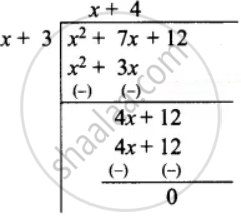Advertisements
Advertisements
प्रश्न
The area of a rectangle is x2 + 7x + 12. If its breadth is (x + 3), then find its length
उत्तर
Let the length of the rectangle be “l”
The breadth of the rectangle = x + 3
Area of the rectangle = length × breadth
x2 + 7x + 12 = l(x + 3)
l = `(x^2 + 7x + 12)/(x + 3)`
= `((x + 4)(x + 3))/(x + 3)`
= x + 4
Length of the rectangle = x + 4

APPEARS IN
संबंधित प्रश्न
Give examples of polynomials p(x), g(x), q(x) and r(x), which satisfy the division algorithm
deg q(x) = deg r(x)
What must be added to the polynomial f(x) = x4 + 2x3 − 2x2 + x − 1 so that the resulting polynomial is exactly divisible by x2 + 2x − 3 ?
Find all zeros of the polynomial 2x4 + 7x3 − 19x2 − 14x + 30, if two of its zeros are `sqrt2` and `-sqrt2`.
Find all the zeros of the polynomial x3 + 3x2 − 2x − 6, if two of its zeros are `-sqrt2` and `sqrt2`
Find the quotient and remainder of the following.
(4x3 + 6x2 – 23x + 18) ÷ (x + 3)
Find the quotient and remainder of the following.
(8y3 – 16y2 + 16y – 15) ÷ (2y – 1)
Find the quotient and remainder of the following.
(−18z + 14z2 + 24z3 + 18) ÷ (3z + 4)
Which one of the following statements is correct?
Can x2 – 1 be the quotient on division of x6 + 2x3 + x – 1 by a polynomial in x of degree 5?
If on division of a non-zero polynomial p(x) by a polynomial g(x), the remainder is zero, what is the relation between the degrees of p(x) and g(x)?
